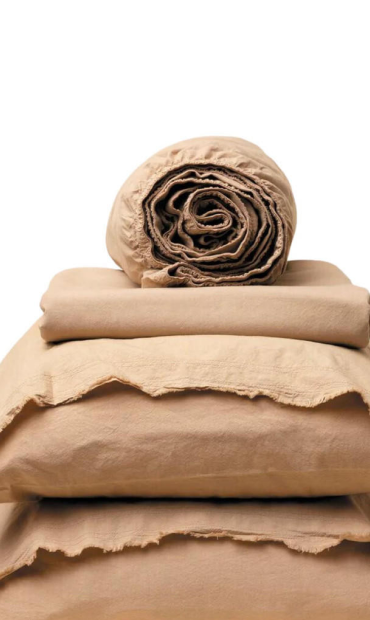Explore the Benefits of Switching to Sustainable Bedding
Posted by Belle and June on October 13, 2023
Bedding plays a critical role in determining the comfort and quality of our sleep. Comprising elements such as mattresses, sheets, pillows, and blankets, they have the power to transform the sleep experience. Modern advancements have allowed for a variety of materials and technologies to be used in bedding, offering options that cater to different preferences and needs.
It's critical to recognize sustainability's role not only in the larger global context but also in our daily lifestyle choices, including the selection of bedding. Sustainable options, made of organic or recycled materials, offer an environmentally friendly alternative, aligning personal comfort with care for the planet.
Sustainability in bedding also refers to the use of environmentally friendly materials and ethical manufacturing practices in the production of bedding items. This could include the use of organic cotton, recycled materials, or natural dyes, and ensuring fair labor practices throughout the supply chain. Sustainable bedding strives to reduce environmental impact, promote social responsibility, and still deliver a quality product for consumers' comfort and health.
Materials for Sustainable Bedding
Organic Cotton
Organic cotton is a prominent choice in eco-friendly bedding. Unlike conventional cotton, organic cotton is grown without the use of harmful synthetic fertilizers or pesticides, thereby minimizing the negative impact on the environment and promoting safer conditions for workers in the field. Organic cotton is typically grown on land that has been treated and prepared without the use of harmful substances for a period of several years.
Organic cotton farming practices strive to maintain soil fertility and reduce the environmental impact, making it a more sustainable and environmentally friendly bedding alternative to conventional cotton farming. GOTS-certified organic cotton sheets are also naturally hypoallergenic, making them an ideal choice for individuals with sensitive skin or allergies.
Hemp
Hemp, a durable and renewable material, is another excellent choice for sustainable sheets. Known for its strength, hemp fabric is naturally resistant to mold and mildew, making it a suitable option for humid climates. This plant grows quickly, requires less water than cotton, and doesn't need synthetic fertilizers or pesticides, making it a much more eco-friendly option.
Moreover, hemp bedding items tend to soften with use without wearing out, ensuring a comfortable and long-lasting sleep experience.
Bamboo
Bamboo is rapidly gaining popularity as a sustainable material for bedding. This fast-growing grass regenerates quickly, requires minimal water, and doesn't necessitate the use of harmful pesticides, making it a highly sustainable option. Bamboo sheets are known for being incredibly soft, often compared to that of cashmere or silk.
Moreover, it has natural antibacterial properties and excellent moisture-wicking ability, making bamboo sheets a great choice for those who value comfort, hygiene, and environmental responsibility.
Tencel/Lyocell
Tencel, also known as Lyocell, is a sustainable fabric derived from the pulp of eucalyptus trees. The process of transforming wood pulp into fabric is highly efficient, employing a closed-loop system that recovers and reuses almost all the solvents. This results in less waste and lower emissions compared to traditional fabric production methods.
Tencel is soft, breathable, and has excellent moisture management properties, making it a comfortable choice for bedding. Moreover, eucalyptus trees require less water and land to grow than cotton, enhancing the environmental benefits of choosing Tencel bedding.
Recycled Materials
Recycled materials are increasingly being used in the production of sustainable bedding. For instance, fabrics can be made from recycled polyester, which is derived from discarded plastic bottles. This not only helps in reducing plastic waste but also consumes less energy than traditional polyester production methods.
Similarly, discarded textiles or post-industrial waste can be repurposed into new, high-quality bedding items. Opting for recycled materials not only reduces landfill waste but also conserves natural resources by reducing the need for new materials.
Wool
Wool stands out as a sustainable material due to its natural abundance and unique properties. It's a renewable resource, with sheep producing a new fleece each year. This biodegradable material has excellent insulation properties, keeping you warm in winter and cool in summer.
Wool also has natural flame resistance and can absorb moisture without feeling wet, promoting a comfortable and safe sleeping environment. Organic wool, in particular, is produced without the use of synthetic hormones or pesticides, making it a healthier choice for both the environment and the consumer.
Organic Linen
Organic linen is a luxurious, sustainable material ideal for bedding. It is derived from the flax plant, which is resilient and can grow in poor-quality soil with minimal water and no need for synthetic pesticides, considerably reducing its environmental impact. The production process of sustainable linen bedding is relatively low-tech, involving less energy and fewer resources than many other fabrics.
Moreover, every part of the flax plant can be used, leaving no waste. Organic linen bedding is known for its breathability and durability, becoming softer and more comfortable with each wash.
When choosing eco-friendly bedding materials, consider certifications such as Global Organic Textile Standard (GOTS) for organic cotton, OEKO-TEX Standard 100 for safe and eco-friendly textiles, or Forest Stewardship Council (FSC) certification for sustainably sourced wood-based materials like Tencel.

Benefits of Buying Sustainable Bedding
Switching to GOTS-certified organic and sustainable bedding offers a range of benefits, not only for the environment but also for your health and overall well-being.
Reduced Environmental Impact
Sustainable bedding significantly reduces environmental impact in numerous ways. Firstly, they are often made from renewable or recycled materials, which cut down on the extraction of virgin resources. Reduced reliance on synthetic fertilizers and pesticides in organic and sustainable farming helps maintain biodiversity and preserve ecosystem health.
Secondly, the manufacturing process of these materials involves closed-loop systems, reducing waste and emissions.
Lastly, because these organic materials are often biodegradable, they don't contribute to long-term landfill waste. Each step in the life cycle of sustainable bedding, from cultivation and manufacturing to disposal, is designed to have the least possible negative effect on the environment.
Lower Carbon Footprint
The use of sustainable bedding contributes to a lower carbon footprint. The cultivation of eco-friendly crops, such as organic cotton, hemp, bamboo, and flax, typically requires fewer fossil fuel-based inputs than conventional farming. Similarly, employing recycled materials or sustainably sourced wood pulp in the production process eliminates the need for energy-intensive extraction and processing of new raw materials.
Improved Indoor Air Quality
Eco-friendly bedding materials partnered with organic mattresses can play a significant role in improving indoor air quality. Conventional bedding materials often contain volatile organic compounds (VOCs) and other chemicals that can off-gas, potentially degrading indoor air quality and causing health issues such as allergies, asthma, or other respiratory problems. In contrast, eco-friendly bed sheets are typically free of these harmful substances.
Healthier Sleep Environment
Switching to eco-friendly bedding made from organic fabrics can lead to a healthier sleep environment. Traditional bedding materials may contain rough chemicals used during manufacturing, which can cause skin irritations, allergies, or respiratory issues.
On the other hand, eco-friendly bedding is generally made from organic materials without the use of these hazardous chemicals, reducing potential health risks. Besides, some eco-friendly materials like bamboo and wool have natural antibacterial and moisture-wicking properties that can help maintain a clean, dry, and hygienic sleep environment.
Comfort and Durability
Sustainable materials are not only eco-friendly but also offer superior comfort and durability. For instance, organic cotton sheets are well-regarded for their softness and breathability, providing a cozy and comfortable sleep experience.
Linen, on the other hand, is known for its exceptional durability and longevity, becoming softer over time. Tencel and bamboo fabrics are silky smooth and gentle on the skin, while also being exceptionally strong and long-lasting. Wool bedding provides excellent insulation, enhancing comfort in both winter and summer and is also naturally durable.
Temperature Regulation
Eco-friendly bedding materials are often excellent at temperature regulation, ensuring a comfortable sleep environment throughout the year. For instance, wool has unique insulating properties that keep you warm in the winter and cool in the summer by wicking away moisture and allowing for good air circulation.
Similarly, materials like bamboo and linen are breathable and have excellent moisture-wicking properties, helping to keep you cool during warmer months. GOTS-certified organic cotton is also breathable and can absorb body moisture, providing a comfortable sleep environment regardless of the season.
Packaging and Shipping for Sustainable Bedding
GOTS-certified organic and sustainable bedding brands typically strive to match their eco-friendly products with equally sustainable packaging and shipping practices. Packaging is often made of recycled, recyclable, or biodegradable materials to cut down on waste. Some companies even opt for plastic-free packaging, using paper or cardboard instead.
When it comes to shipping, many sustainable companies offset their carbon emissions by investing in carbon offset projects. These initiatives might involve tree planting, renewable energy, or energy efficiency projects. Additionally, some sustainable bedding brands use shipping carriers that offer eco-friendly options, like ground shipping, which has a lower environmental impact than air shipping.

By choosing eco-friendly bedding brands that pay attention to not only the sustainability of their products but their packaging and shipping practices as well, consumers can ensure they are making the most eco-friendly choices for their bedding needs.
Care and Maintenance for Your Sustainable Bedding
Taking proper care of your sustainable bed sheets is essential to prolong their lifespan and maintain their eco-friendly qualities. Here are some care and maintenance tips for your sustainable bedding.
Read Care Labels
Always begin by reading the care labels on your sustainable bedding products. These labels provide crucial information about the suitable cleaning methods for the material. Some sustainable materials might be machine washable, while others may require hand washing or dry cleaning.
Regular Washing
Regular washing is essential to keep your sustainable bedding clean and hygienic. However, it's important to remember that over-washing can cause unnecessary wear and tear.
Depending on the material, washing your bedding once a week to once every two weeks is often sufficient. Aim to use a gentle, eco-friendly laundry detergent that doesn't contain rough chemicals. This is not only better for the environment but can also prolong the lifespan of your bedding.
Use Cold Water
When washing your bed sheets, choose to use cold water instead of hot. Cold water is just as effective for cleaning bedding, and it's much gentler on the fibers, helping to preserve their natural texture and prolong their lifespan.
Additionally, using cold water for laundry is a more energy-efficient choice, as it reduces the amount of energy needed for heating water, thus contributing to overall household energy savings.
Eco-Friendly Detergents
When it comes to washing your sustainable bedding, choosing eco-friendly detergents is as crucial as the proper washing techniques. Conventional detergents often contain harmful chemicals that are not only damaging to the environment but can also be harsh on your bedding materials, shortening their lifespan.
On the other hand, eco-friendly detergents are typically made with plant-based ingredients that are biodegradable and free of harsh chemicals. They effectively clean your bedding without causing unnecessary harm to the fabric or the environment. Additionally, these detergents are usually packaged in sustainable or recyclable containers, further reducing their environmental impact.
Avoid Fabric Softeners
While fabric softeners may seem like a good idea to keep your sustainable bedding soft and smelling fresh, they can actually do more harm than good. Many conventional fabric softeners contain harmful chemicals that can degrade the natural fibers of your bedding over time, reducing its lifespan. Moreover, these chemicals can also wash off into our water systems, posing a threat to the environment. Instead of fabric softeners, consider using natural alternatives such as vinegar or wool dryer balls. These natural substitutes can soften your bedding without the use of harsh chemicals, preserving both your bedding and the environment.
Gentle Cycle
Choosing the gentle cycle on your washing machine can significantly extend the life of your sustainable bedding. This cycle uses a slower, less intense pace which results in less friction and wear on the fabric. Furthermore, it reduces energy consumption, aligning with the eco-friendly nature of your bedding. Selecting the gentle cycle and lower spin speed when washing and rinsing your bedding can make a big difference in maintaining the quality and durability of your sustainable products.

Line Drying or Low Heat
Whenever possible, opt for line drying your sustainable bedding. This method is the most environmentally friendly, as it utilizes natural sunlight and wind for drying, consequently saving considerable amounts of energy typically used for machine drying.
Not only does line drying reduce energy consumption, but it also preserves the integrity of your bedding, as heat from dryers can cause shrinkage and damage organic fibers over time. If line drying isn't feasible due to weather conditions or space constraints, use your dryer in a low-heat setting.
Store Properly
The way you store your eco-friendly bed sheets also plays a significant role in maintaining their quality and longevity. After thoroughly cleaning and drying your bedding, ensure it's neatly folded and stored in a cool, dry place away from direct sunlight. The use of breathable fabric bags or containers is recommended to prevent the accumulation of moisture, which could lead to mildew or mold.
Organic fiber bedding such as cotton, bamboo, or linen should not be stored in plastic containers as they need good air circulation. If you need to store your bedding for an extended period, consider placing it in a bag with natural pest repellents, such as lavender or cedarwood, to keep insects at bay. Regularly check and rotate your stored bedding to ensure it maintains its freshness and quality.
By following these care and maintenance tips, you can extend the life of your sustainable bedding while reducing its environmental impact and ensuring a comfortable and healthy sleep environment.

